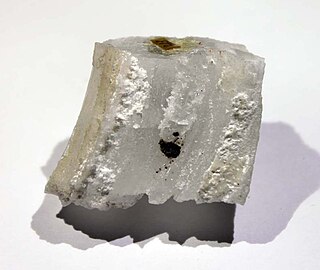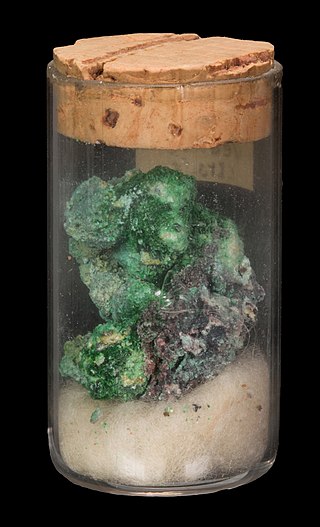Related Research Articles

Electrochemistry is the branch of physical chemistry concerned with the relationship between electrical potential difference and identifiable chemical change. These reactions involve electrons moving via an electronically-conducting phase between electrodes separated by an ionically conducting and electronically insulating electrolyte.

Basic copper carbonate is a chemical compound, more properly called copper(II) carbonate hydroxide. It is an ionic compound consisting of the ions copper(II) Cu2+
, carbonate CO2−
3, and hydroxide OH−
.

Magnesium sulfate or Magnesium sulphate is a chemical compound, a salt with the formula MgSO4, consisting of magnesium cations Mg2+ (20.19% by mass) and sulfate anions SO2−4. It is a white crystalline solid, soluble in water but not in ethanol.

Lead(II) sulfate (PbSO4) is a white solid, which appears white in microcrystalline form. It is also known as fast white, milk white, sulfuric acid lead salt or anglesite.

Jarosite is a basic hydrous sulfate of potassium and ferric iron (Fe-III) with a chemical formula of KFe3(SO4)2(OH)6. This sulfate mineral is formed in ore deposits by the oxidation of iron sulfides. Jarosite is often produced as a byproduct during the purification and refining of zinc and is also commonly associated with acid mine drainage and acid sulfate soil environments.

Sodium sulfate (also known as sodium sulphate or sulfate of soda) is the inorganic compound with formula Na2SO4 as well as several related hydrates. All forms are white solids that are highly soluble in water. With an annual production of 6 million tonnes, the decahydrate is a major commodity chemical product. It is mainly used as a filler in the manufacture of powdered home laundry detergents and in the Kraft process of paper pulping for making highly alkaline sulfides.

Mendozite is a sulfate mineral, one of the alum series, with formula NaAl(SO4)2·11H2O. It is a hydrated form of sodium aluminium sulfate (soda alum).

Sodium aluminium sulfate is the inorganic compound with the chemical formula NaAl(SO4)2·12H2O (sometimes written Na2SO4·Al2(SO4)3·24H2O). Also known as soda alum, sodium alum, or SAS, this white solid is used in the manufacture of baking powder and as a food additive. Its official mineral name is alum-Na (IMA symbol: Aum-Na).

Cobalt(II) sulfate is any of the inorganic compounds with the formula CoSO4(H2O)x. Usually cobalt sulfate refers to the hexa- or heptahydrates CoSO4.6H2O or CoSO4.7H2O, respectively. The heptahydrate is a red solid that is soluble in water and methanol. Since cobalt(II) has an odd number of electrons, its salts are paramagnetic.

Shigaite is a mineral with formula NaAl3(Mn2+)6(SO4)2(OH)18·12H2O that typically occurs as small, hexagonal crystals or thin coatings. It is named for Shiga Prefecture, Japan, where it was discovered in 1985. The formula was significantly revised in 1996, identifying sodium as a previously unknown constituent.

Gordaite is a sulfate mineral composed primarily of hydrous zinc sodium sulfate chloride hydroxide with formula: NaZn4(SO4)(OH)6Cl·6H2O. It was named for the discovery location in the Sierra Gorda district of Chile. Gordaite forms as tabular trigonal crystals.
Itelmenite is a rare sulfate mineral with the formula Na4Mg3Cu3(SO4)8. It is one of many fumarolic minerals discovered on the Tolbachik volcano.
Wulffite is an alkali copper sulfate mineral with the chemical formula K3NaCu4O2(SO4)4, in the sulfate category of minerals. It was recently discovered in Kamchatka, Russia at the Tolbachik volcano in 2012. It was named for Russian crystallographer Georgiy Viktorovich Wulff, a renowned expert who furthered X-ray diffraction and interference. Wullfite shares many properties with parawulffite, which was found in the same area just with slightly different chemical composition.

Euchlorine (KNaCu3(SO4)3O) is a rare emerald-green colored sulfate mineral found naturally occurring as a sublimate in fumaroles around volcanic eruptions. It was first discovered in fumaroles of the 1868 eruption at Mount Vesuvius in Campania, Italy by Arcangelo Scacchi. The name 'euchlorine' comes from the Greek word εΰχλωρος meaning "pale green" in reference to the mineral's color, other reported spellings include euclorina, euchlorin, and euchlorite.

The sulfate carbonates are a compound carbonates, or mixed anion compounds that contain sulfate and carbonate ions. Sulfate carbonate minerals are in the 7.DG and 5.BF Nickel-Strunz groupings.
The sulfate fluorides are double salts that contain both sulfate and fluoride anions. They are in the class of mixed anion compounds. Some of these minerals are deposited in fumaroles.

Fumarole minerals are minerals which are deposited by fumarole exhalations. They form when gases and compounds desublimate or precipitate out of condensates, forming mineral deposits. They are mostly associated with volcanoes following deposition from volcanic gas during an eruption or discharge from a volcanic vent or fumarole, but have been encountered on burning coal deposits as well. They can be black or multicoloured and are often unstable upon exposure to the atmosphere.
The phosphate sulfates are mixed anion compounds containing both phosphate and sulfate ions. Related compounds include the arsenate sulfates, phosphate selenates, and arsenate selenates.
Aleutite is both a vanadate and arsenate mineral but it can also be considered as a natural salt-inclusion phase that was first discovered at Second scoria cone of the Great Fissure Tolbachik eruption in the summer of 2015 in Kamchatka, Russia. Aleutite is a fumarolic mineral found with many other newly discovered minerals at this location. It gained the name from the Aleuts, the ethnic group who are the original inhabitants living on the Commander Islands, Aleutsky District, Kamchatka Krai. This mineral is very brittle and has a dark red color. Aleutite is a new structure type, the structure was refined as a 2-component twin, the twin ratio equals (0.955:0.045).
References
- ↑ "Newly discovered mineral petrovite could revolutionize batteries". Big Think. 2020-11-20. Retrieved 2021-01-16.
- ↑ "Petrovite: Scientists discover a new mineral in Kamchatka". phys.org. Retrieved 2021-01-16.
- ↑ Filatov, Stanislav K.; Shablinskii, Andrey P.; Krivovichev, Sergey V.; Vergasova, Lidiya P.; Moskaleva, Svetlana V. (October 2020). "Petrovite, Na10CaCu2(SO4)8, a new fumarolic sulfate from the Great Tolbachik fissure eruption, Kamchatka Peninsula, Russia". Mineralogical Magazine. 84 (5): 691–698. Bibcode:2020MinM...84..691F. doi: 10.1180/mgm.2020.53 . ISSN 0026-461X. S2CID 225662607.